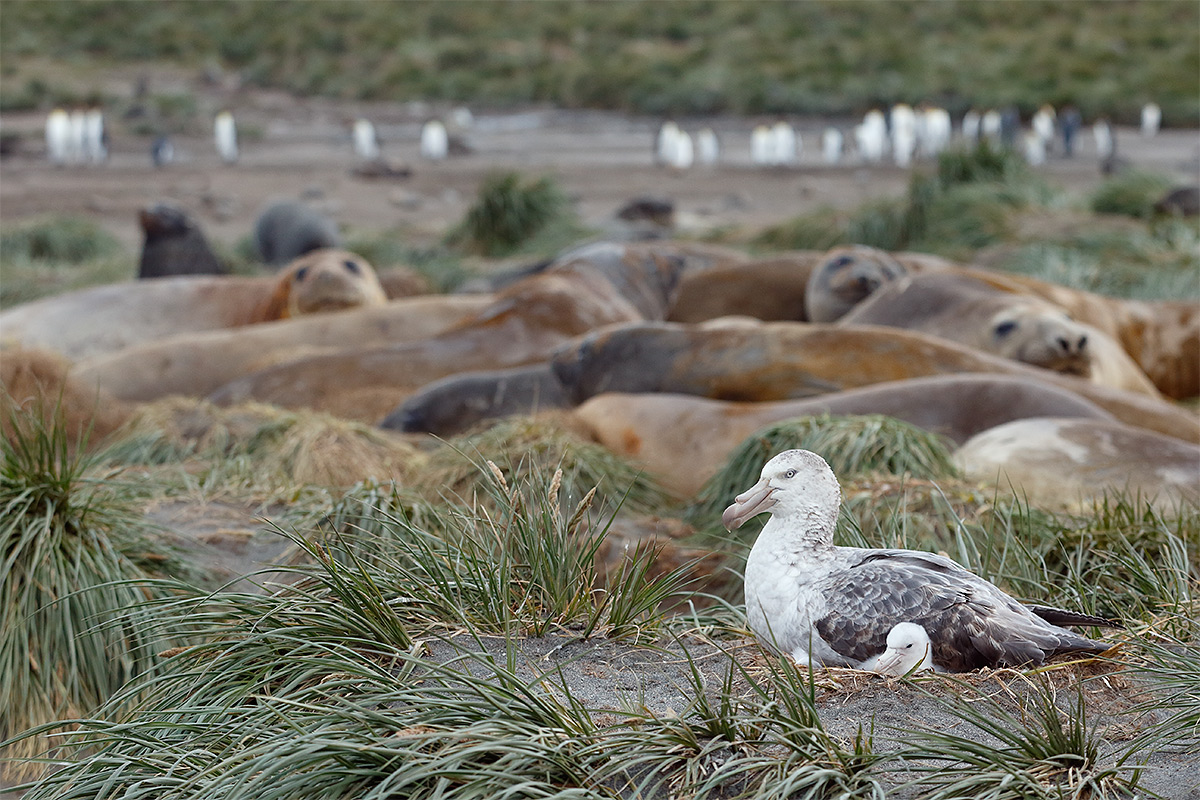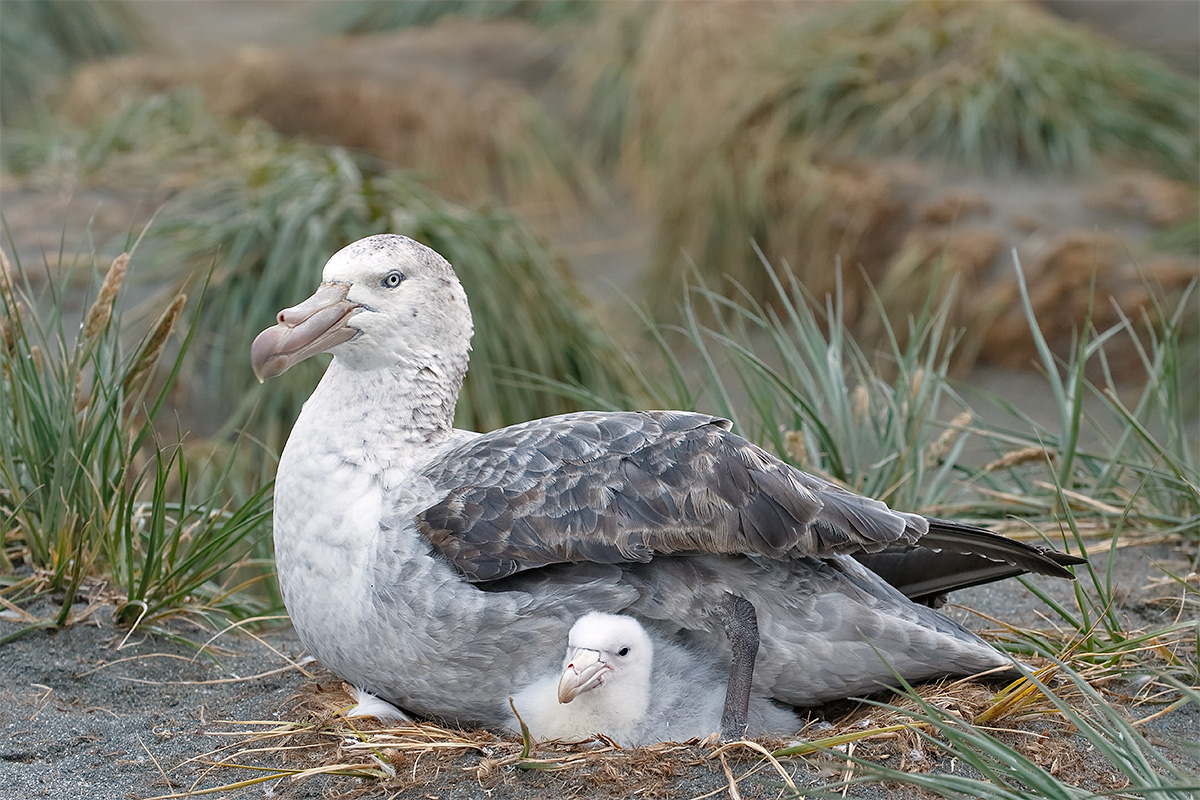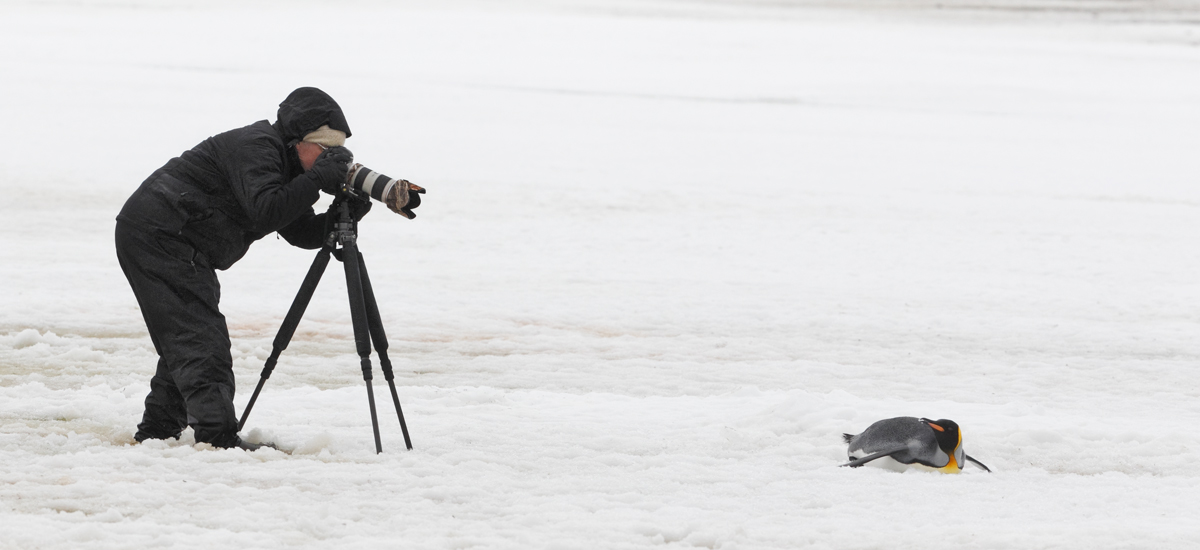What’s up?
The IPT group thrilled on a gorgeous red sunrise from Steptoe Butte. Long lenses were best, the longer the better. I shared my 200-400 with the internal TC in place and an external TC added with several participants, and opened Bill Keay’s eyes to the possibilities as he has owns the lens. Then it was old barns and farm houses. With lots of lessons and lots of learning throughout, and a bit of IR as well. Folks who do not have an IR body were invited to give it a try.
|
This image was created at Salisbury Plain, South Georgia with the tripod-mounted Canon EF 70-200mm f/2.8L IS II USM lens, the Canon Extender EF 1.4X III (at 135mm), and the Canon EOS-1D X . ISO 1600. Evaluative metering at zero: 1/250 sec. at f/5.6. Center AF point/AI Servo Expand/Rear Focus AF on the adult’s eye and re-compose. Click here to see the latest version of the Rear Focus Tutorial. Click on the image to see a larger version. Image #1: Northern Giant Petrel with chick on nest/wide habitat shot |
In the Northern Giant Petrel Large-in-the-frame or Habitat Shot… here, I asked seven questions included one mis-guided poor one. You will find each of those along with my answers and comments below.
Surprise Miracle on Salisbury Plain
Northern Giant Petrel nests in many locations on South Georgia. Many of those are off limits to visitors. In places you severely are restricted from approaching a nest. Because of severe weather delays due to high winds on our crossing from The Falklands we missed our scheduled landing at Salisbury Plain, one of several hard-to-believe King Penguin nesting sites in South Georgia. Our expedition leader was able to make a deal with another so that we were able to land at about 4:00am. And we needed to be off the beach by 8:00am.
Advance crew member landing parties land before any of the trip participants to make sure that things are do-able and safe and to stake out a path through the furs seals. As I made my way up the beach I was astounded to see a completely unperturbed Northern Giant Petrel sitting on both its nest and a small white chick. Talk about striking it rich. As our path was within scant yards of the nest all the photographers needed to do was walk slowly and stay a bit on the quiet side. And that is exactly what we did.
|
This image was created at Salisbury Plain, South Georgia with the tripod-mounted Canon EF 70-200mm f/2.8L IS II USM lens, the Canon Extender EF 1.4X III (at 240mm), and the Canon EOS-1D X . ISO 1600. Evaluative metering +1 /3 stop: 1/125 sec. at f/8. One row down and four AF points to the left of the center AF point/AI Servo Expand/Rear Focus AF as framed was active at the moment of exposure. The selected AF point fell on the the adult’s neck well below the eye and just forward of the feathers of the upper back. Click here to see the latest version of the Rear Focus Tutorial. Click on the image to see a larger version. Image #2: Northern Giant Petrel with chick/tight |
Seven South Georgia Giant Petrel With Chick Answers
#1: Which image do you like best, the habitat shot or the tight shot? Why?
am: I like both but feel that the wider image is a better image for the reason mentioned in #6 below.
#2: Why was f/8 needed for the tight image?
am: Depth-of-field increases with the camera to subject distance. The closer you get to the subject, the more concerned you need to be about depth-of-field issues.
#3: Are the two exposure the same?
1/250 sec.at f/5.6. 1/125 at f/8. With a one stop slower shutter speed combined with a one stop smaller aperture the exposures are identical. Most folks got this one right.
#4: Why +1/3 stop for Image #2 but zero for the first image?
am: A larger area of light tones on the adult’s breast would influence the meter to underexposure.
#5: Which image was created first, #1 or #2? (You need to know me to get this one right….)
am: Folks who know me know that I will always go for the tight shot first and then think wide/environmental.
#6: What do I like least about Image #2?
Late commenter Mal Graham said it perfectly: #2. I feel that a little more space below the chick would make it feel more balanced. The little fella is getting squeezed from above by mum and from below by the bottom of the frame. Zooming out a bit wider would have had multiple benefits: in addition to adding a bit more room below the birds I could have included the complete tuft of grass in front of the birds.
#7: Why did I choose the exact same line of sight for both images?
am: This was the faulty question has I had not chosen the exact same line of sight…. I was fooled by the fact that the adult’s head was (properly) set against a similar tuft of tussock grass… With heavy cloud cover, sun angle was not an issue.
|
All of the images on the card were made on South Georgia. This remote wilderness island offers both spectacular scenery and hordes of tame wildlife and birds. From top left clockwise to the center: Southern Elephant Seal, courting King Penguin pair, King Penguin abstract, Grey-headed Albatross, King Penguin rookery on Salisbury Plain, Macaroni Penguin head portrait, King Penguin molting Okum Boy, Macaroni Penguin pair, King Penguin preening, Southern Elephant Seal yawning, the view of Gold Harbour from a Light-mantled Sooty Albatross nest. Click on the image to see an extra large version. |
The Southern Ocean
South Georgia Expedition Voyage
I’ve been blessed. I’ve now made four trips to the Southern Ocean, three expeditions that visited the Falklands, South Georgia, and the Antarctic Peninsula, and one to the Falklands and South Georgia. Each was a truly amazing experience. South Georgia has been the star of the show each time: rugged snow covered peaks, tame and abundant wildlife including Southern Elephant Seal and Southern Fur Seal, and penguins: more King Penguins than you could ever have dreamed of. Gentoos. And my favorite, the golden-yellow spaghetti-topped Macaronis. With four trips to South Georgi under my belt, I have a pretty good idea about how to make great images at each of the iconic landings. In addition, we should have some pretty good flight photography sessions from the stern of the ship. I would love the chance to share my knowledge with you.
Going Light
On my recent trip, I found myself going with shorter lenses and lighter gear than on any previous Southern Ocean Expedition. In part that was due to the crop factor of the 7D Mark II, in part because going light makes life (and landings!) much easier. I made many landings with just the 7D II and the 70-200mm f/2.8L IS. I refined the way that I got my gear safely from ship to shore. Lots more on that here soon.
Cheesemans’ Well Deserved Kudos
I know from personal experience that if you are a photographer who is going to invest in Southern Ocean voyage, you will want to put your money on Cheesemans’. No other tour company goes as far out of their way to ensure making every possible safe landing. And no other tour company will have you spending more time on land. Michael Viljeon from South Africa was aboard the Ortelius on a Southern Oceans voyage that preceded the Cheesemans’ trip that we were both on. As we headed back to Ushuaia, he said, “The folks that ran that first trip were pathetic. Too rough. No landing today. Surf too high today. No landing. Wind wrong direction. No landing. Cheesemans’ routinely and safely gets folks on land in conditions where the leaders of other tour companies do not even bother getting out of their bunks.”
Here, from the” Way to Go CES! (Cheeseman’s Ecology Safaris)” blog post here, is one of my favorite Cheesemans’ stories:
The landing at Bailey Head, Antarctica, was especially rewarding to me as I had been sitting in a zodiac 100 yards off shore on my 2007 trip when the zodiac in front of mine swamped and the captain of the ship called off the landing…. Early that day it looked as if my weather Karma might not be working. Ted’s “Good morning shipmates” was followed by the news that we would not be able to land at Bailey Head that morning as the swell was too big. The beach there is sloped tremendously and the sea strives to pull the zodiacs back into the ocean before folks have gotten off with their gear. Tom Murphy had said to me several days before, “We will get you on the beach at Bailey Head.” Ted concluded his morning greetings by saying, “We are sending out a scout team to see if landing is possible.”
After breakfast I was thrilled to hear Ted’s voice again on the PA, “We will be landing at 8am.” Afterwards folks noted that it was the calmest landing ever at this amazingly beautiful spot. My good weather Karma (courtesy of late-wife Elaine) had come through one last time. Along with St. Andrews Bay, it was one of my two favorite super-great once-in-a-lifetime days of the trip. And we even got to enjoy three additional hours at Hannah Point, Antarctica before calling it a wrap and heading for the feared Drake Passage. All thanks to Cheesemans’ Ecology Safaris.
Why Sign Up Through BIRDS AS ART?
If you have been thinking and dreaming of finally visiting South Georgia, this is the trip for you. Quit dreaming and act now. Though I will not be an official leader on this trip, those who have traveled with me know that I cannot help but teach. I will make pre-trip gear recommendations. I will hold informal pre-landing briefings. In the same vein, everyone will receive a free copy of our Antarctica Site Guide once they are paid in full (July 2, 2015). I will be available on the ship to review your images,, answer questions, and conduct informal over-the shoulder Photoshop sessions. And best of all, everyone who signs up under the auspices of BAA are invited to tag along with me on the landings where I will be glad to offer invaluable in-the-field advice. And the same goes for the ship-board birds in flight and marine mammal photography opportunities.
Do join us. To learn how to be part of the BAA group please e-mail me with the words Antarctica/Extended Expedition BAA Info Please cut and pasted into the Subject line.
Important Notes
#1: If you fail to e-mail me as noted directly above, and register directly with CES you MUST let them know that you would like to be part of the BIRDS AS ART group.
#2: Joining the BIRDS AS ART group as above will not cost you one penny.
The Cheesemans’ Ecology Safaris South Georgia Expedition Voyage
An in-depth Adventure aboard the Ortelius: October 29 to November 17, 2015
From the CES website:
We are very excited to be able to bring this special in-depth expedition to you. This is a product of years of experience leading voyages to South Georgia and a passion for everything found here. Our itinerary is specifically designed to take advantage of the vibrant early season on South Georgia when snow blankets the mountains and early summer brings special wildlife treats seldom experienced. We will explore vast colonies of King Penguins, elephant seals in their peak of breeding activity, and colonies of Wandering, Gray-headed, Light-mantled, and Black-browed albatross. This cruise allows us many days to explore this truly unique island, the crown jewel of the Antarctic. The landscape filled with expanses of glaciers pouring into the sea provides rare beauty and photogenic impressiveness that words cannot convey. We will enjoy about nine days in the midst of the most beautiful and wildlife-rich island on the planet! Exceptional leadership expertise will enrich your experience throughout the voyage. Our priority on this special expedition is to give you the maximum time possible in the field so you can explore at your own pace during a special time on South Georgia. Come explore South Georgia with us!
I can personally attest to the accuracy of everything above. 🙂
|
This could be you! Pat Lillich and King Penguin in snow. There is a much greater chance of snow in October than in December/January and for photography, fresh snow rocks! |
More CES Kudos
From multiple IPT veteran Alan Lillich who (along with wife Pat) was in the BAA group on a 2012 CES voyage with me:
Start with some of the world’s best alpine landscapes, add an overwhelming abundance of tolerant wildlife, and finish with tour operators who put you there and give you the freedom to explore. It doesn’t get any better.
The Pull is Too Strong…
The pull is too strong. I need to go back. And I am. Do join me for an unparalleled wildlife and scenic photography experience. Please e-mail for additional information or with questions.

















